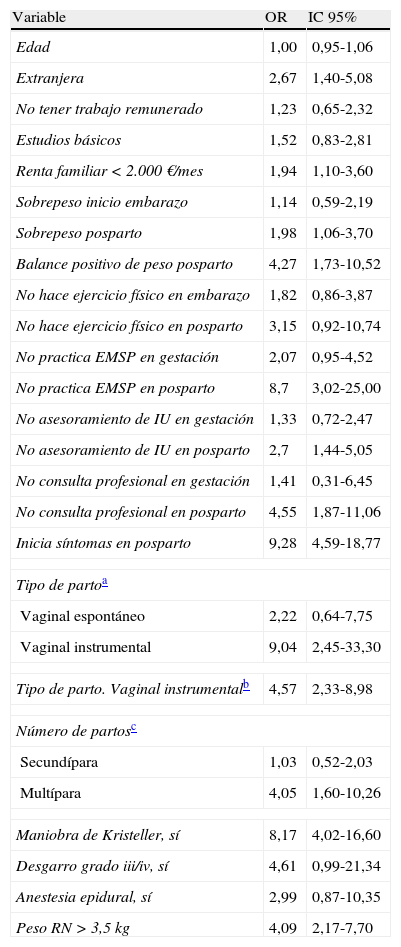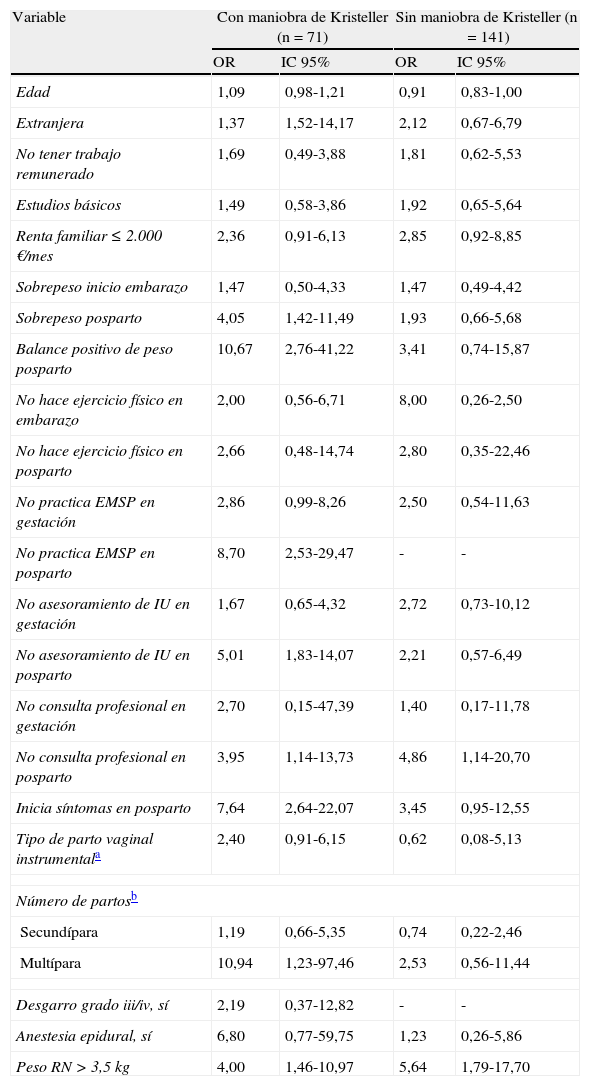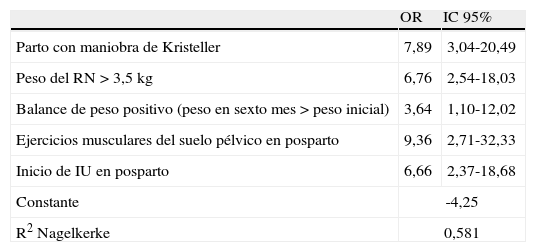La incontinencia urinaria iniciada antes y justo después del parto y que persiste tras 3 meses de posparto tiende a cronificarse. El objetivo de este estudio fue estimar la persistencia de incontinencia urinaria a los 6 meses del parto y analizar los factores que se asocian con ella.
Pacientes y métodoEstudio de seguimiento tras 6 meses posparto de mujeres que inician síntomas de incontinencia en gestación o 2 primeros meses de posparto. La variable dependiente fue la persistencia y las independientes se agruparon en obstétricas y no obstétricas. En el análisis bivariante se calcularon las odds ratio (OR) con sus intervalos de confianza del 95% (IC 95%). Con las variables que mostraron riesgo importante de persistencia de incontinencia se realizó un modelo de regresión logística multivariante.
ResultadosLa persistencia de incontinencia urinaria tras 6 meses posparto fue del 21,4% (IC 95% 16-26,7). El riesgo de persistencia aumentó con maniobra de Kristeller (OR 7,89, IC 95% 3,04-20,49), no recuperación de peso (OR 3,64, IC 95% 1,10-12,02), no realización de ejercicios musculares del suelo pélvico en posparto (OR 9,36, IC 95% 2,71-32,33), aparición de incontinencia tras el parto (OR 6,66, IC 95% 2,37-18,68) y peso del recién nacido>3,5kg (OR 6,76, IC 95% 2,54-18,03), que explican el 58% de la variabilidad de la persistencia.
ConclusiónUn 21,4% de mujeres con incontinencia urinaria causada por embarazo/parto seguirán padeciéndola pasados 6 meses del alumbramiento. Parte importante de esta persistencia se asocia a factores fácilmente modificables.
Urinary incontinence initiated before and right after delivery and persisting 3 months after delivery tends to become chronic. We intended to estimate the persistence of urinary incontinence 6 months postpartum and to analyse the different factors associated with it.
Patients and methodsFollow-up study 6 months after delivery of women presenting urinary incontinence symptoms in gestation or in the first 2 months of postpartum. The dependent variable was the persistence and the independent variables were grouped in obstetric and non-obstetric. Odds ratio (OR) were calculated with their confidence interval at 95% (IC 95%) in the bivariate analysis. The variables that showed an important risk of persistence of incontinence were used to perform a multivariate model of logistic regression.
ResultsThe persistence of incontinence 6 months after delivery was 21.4% (CI 95% 16-26.7). The risk of persistence increased with the Kristeller maneuver (OR 7.89, CI 95% 3.04-20.49), not weight recovery (OR 3.64, CI 95% 1.10-12.02), not practising pelvic floor muscle exercises in postpartum (OR 9.36, CI 95% 2.71-32.33), appearance of incontinence after delivery (OR 6.66, CI 95% 2.37-18.68) and the weight of the newborn>3.5kg (OR 6.76, CI 95% 2.54-18.03), all of them explaining 58% of the variability of persistence.
Conclusion21.4% of women with urinary incontinence caused by pregnancy/delivery will continue to have it 6 months postpartum. An important part of this persistence is associated with some factors easy to modify.
Artículo
Comprando el artículo el PDF del mismo podrá ser descargado
Precio 19,34 €
Comprar ahora











